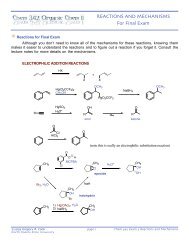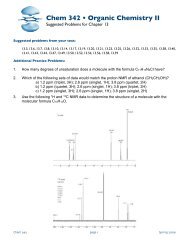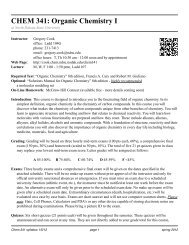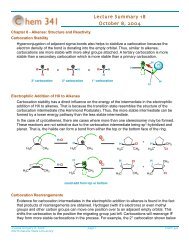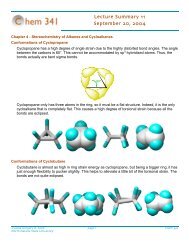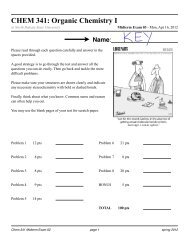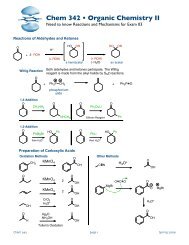Lecture Summary 29 November 3, 2006 - Cook Group
Lecture Summary 29 November 3, 2006 - Cook Group
Lecture Summary 29 November 3, 2006 - Cook Group
You also want an ePaper? Increase the reach of your titles
YUMPU automatically turns print PDFs into web optimized ePapers that Google loves.
<strong>Lecture</strong> <strong>Summary</strong> <strong>29</strong><strong>November</strong> 3, <strong>2006</strong>Chapter 11 - Reactions of Alkyl Halides: Nucleophilic Substitutions and EliminationsSN2 Reaction Details - Leaving <strong>Group</strong>The leaving group has a big influence on the substitution reaction as well. The weaker the bond(longer bonds are weaker), the better a leaving group is. Also, the more stable the leaving group isafter the bond has broken, the easier it can come off. Thus, more stable anions will be betterleaving groups. The tosylate group ( - OTos) is one of the best leaving groups.LEAVING GROUPRELATIVE RATEFOR S N 2TosO - I - Br - Cl - F - HO - NH 2-60,000 30,000 10,000 200 1
CH δ+3 CH 3SH 3 C δ- OCH 3δ+ δ- δ-SOS δ+OCH 3 NaCH 3δ-δ-OOH 3 C S δ-O S CH 3δ+δ+CH 3 S CH 3CH 3 δ+ CH3δ-OH 3 C Sδ+CH 3Nucδ+ CH 3CH 3 SO δ-Polar aprotic solvents canseparate and stabilize ionicreagents.HH O HO HHH OOHNucHHOHHOHO HHPolar protic solvents like water will surround anucleophile making it less reactive. Thus, proticsolvents retard the rate of S N 2 reactions.SN1 Reaction Details - SubstrateSince the nucleophile is not involved in the rate determining step of the SN1 reaction, theimportant feature here is the stability of the carbocation intermediate that is being formed. Tertiarysubstrates are best for this reaction. Secondary substrates are very slow, however if they are nextto an alkene, resonance can greatly stabilize the carbocation and make SN1 more favorable.HRRRSUBSTRATEH HCIC IC IC IH R R methyl H 1° H 2° R 3°RELATIVE RATEFOR S N 11 1 12 1,200,000Br©<strong>2006</strong> Gregory R. <strong>Cook</strong> page 2 Chem 341North Dakota State University
SN1 Reaction Details - NucleophileThe nucleophile is not very important for a SN1 reaction. This is because it is not involved in therate determining step. Even weak nucleophiles like neutral water will react with a carbocationwhen it’s formed. The major concern is problems with competing elimination reactions when thenucleophile is too basic.SN1 Reaction Details - Leaving <strong>Group</strong>The leaving group has a big influence on the substitution reaction for SN1 just as we saw with SN2since the leaving group leaves in the rate determining step. The weaker the bond (longer bondsare weaker), the better a leaving group is. Also, the more stable the leaving group is after the bondhas broken, the easier it can come off. Thus, more stable anions will be better leaving groups. Thetosylate group ( - OTos) is one of the best leaving groups.SN1 Reaction Details - SolventsWhat was bad for the nucleophile in SN2 reactions is great for the leaving group as it comes off.The protic solvents will stabilize the anion with it’s acidic protons. Also, the polar solvents willstabilized the carbocation when it’s formed. Thus, polar protic solvents are best for aiding the ratedetermining step of the SN1 reaction.HHδ−OHHHO δ−δ−OHRHδ−OHOδ−δ−HHOHHPolar solventsstabilize thecarbocation bysurrounding it withthe negativelycharged oxygensH OHOHHHHOOBrHHHHHOHOHOHProtic solventsstabilize the leavinggroup bysurrounding it withacidic protonsStereochemistry of Substitution ReactionsSN2 reactions on chiral substrates will proceed with complete inversion of the stereochemistry. In aSN1 reaction, stereochemistry is lost when you form the planar (achiral) carbocation. Thenucleophile may approach from either side with equal probability. Thus, racemic products areformed.BrNaCNDMSOS N 2CNBrNaOAcAcetic AcidS N 1OAc+OAc50 : 50©<strong>2006</strong> Gregory R. <strong>Cook</strong> page 3 Chem 341North Dakota State University
SN1 and SN2 ComparisonBelow is a table comparing the features important for each mechanism for substitution. Thesubstrate type is probably the most important factor.S N 1 S N 2SUBSTRATE 3° >> 2° > 1° 1° > 2° >> 3°NUCLEOPHILE Weak OK StrongLEAVING GROUP Stable Anions Stable AnionsSOLVENT Polar Protic Polar AproticSTEREOCHEM Racemic 100% inversionHere are some examples of the affects of these mechanisms on the reaction of an alcohol. Notethat carbocations generated during SN1 reactions can undergo rearrangements. An alcohol can beactivated into a leaving group two ways . . making a tosylate or making a halide. Note that thetosylate formation does not alter the C-O bond stereochemistry whereas PBr3 or SOCl2 will invertthe alcohol stereochemistry when the halide is formed. Nucleophiles and halides in the samemolecule can undergo cyclization reactions.OHHBrcarbocationrearrangementBrOHTos-ClO Tos NaCNCNpyridineDMFinversionOHPBr 3BrNaCNCNinversionDMFinversionBrOHNaHBrOO©<strong>2006</strong> Gregory R. <strong>Cook</strong> page 4 Chem 341North Dakota State University



